“We are headed for catastrophe if we don’t make huge changes in the way we live and treat the earth and its limited resources. Concern is not enough, we need action.”
— Chloe Eudaly, PBOT Commissioner
The City of Portland officially kicked off the Rose Lane Project Thursday night at a special Portland City Council meeting that focused on climate change and was held on the campus of Portland Community College Southeast at 82nd and Division. It was a fitting time and place to unveil a project that could lead to the most significant transformation of how Portlanders get around since we built those damn freeways decades ago.
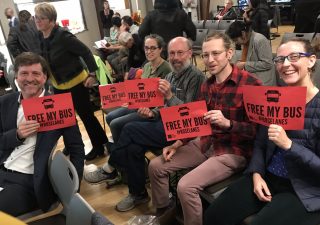
(Photo: J. Maus/BikePortland)
“Fast, frequent, full” was the mantra unveiled Thursday night that encapsulates PBOT Commissioner Chloe Eudaly’s strategy to speed up buses, increase service and boost ridership.
To meet goals adopted in the Climate Action Plan and Transportation System Plan, Portland needs to more than double the amount of daily commute trips made by transit by 2035. In PBOT’s words as published on the new Rose Lane Project website, “We have work to do.”
The Rose Lane Project is being pitched as an “accelerated implementation” of the PBOT’s Enhanced Transit Corridors plan which was adopted by City Council last year. So far, its development has been led by an internal advisory group convened by Eudaly’s Policy Director Jamey Duhamel. That group included: The Street Trust, OPAL, Urban League, Oregon Walks, Community Cycling Center, PAALF, Unite Oregon, APANO, Safe Routes Partnership, Better Business PDX, Rosewood Initiative, Portland State, Portland Bus Lane Project, and Verde.
At last night’s meeting, Eudaly sought council approval of the project’s initial report.
“We are deeply concerned about the climate and the world we are leaving for our children,” Eudaly said in an introduction of the report. Taking action on climate – and making sure that action benefits people of color — was a strong theme throughout the meeting and especially during the Rose Lane Project presentation.
Eudaly has embraced transit because she feels it’s the most efficient, equitable, and sustainable way to move lots of people. Here’s an excerpt from her remarks:
“We are headed for catastrophe if we don’t make huge changes in the way we live and treat the earth and its limited resources. Concern is not enough, we need action.
I asked PBOT staff to do a quick, back-of-the-envelope estimate on the kind of change we need to see in order to have a fighting chance to avert the path we are on. What they came up with is that every resident of Portland who currently drives a single-occupancy vehicle needs to reduce their car trips by 50%. For those of us who live in bikeable, walkable, and transit-rich neighborhoods, that should be easily achievable — unless your car is part of your job or you have some other challenge. But for the nearly 50% who don’t live in such a neighborhood, or who have such long commutes that public transportation is not a viable option, we must do better.”
Advertisement
During Duhamel’s testimony last night, she spoke about the connection between transportation and race in a way I don’t think we’ve ever heard from someone in her position. Agencies love to talk about using an “equity lens” these days; but Duhamel’s approach feels more intentional than anything I’ve covered in the past. And while this approach might sound new to some Portlanders, it fall directly in line with a burgeoning mobility justice movement.
The problematic fact that our transportation system disproportionately impacts people of color is at the core of what the Rose Lane Project wants to fix. Duhamel testified that this inherent bias is why their approach focused first on building relationships with community groups that make up their internal advisory panel. Their approach put the expertise of people with lived experience front-and-center. It brought voices of people on the frontlines of disparity to a level of influence on par with traditional inputs like the expertise of planners and engineers or traffic data and modeling.

Duhamel said root disparities in the current system prevent us from achieving results that would correct them and that any additional planning work is, “Either actively dismantling systems of racism and oppression or it is actively causing additional harm.”
“Our primary goal is to allow people of color to reduce their commute time.”
— Jamey Duhamel, Commissioner Eudaly’s policy director
With this frame, Duhamel said they’ve identified commute times as a “condition of inequity causing harm to people of color”.
Citing U.S. Census data, Duhamel shared that the average black commuter spends an additional five minutes each way commuting to work. That pencils out to one week a year sitting in traffic. “Add to that, research that finds commute times are the single most important factor that helps people out of poverty and into economic opportunity,” Duhamel testified, “and it becomes crystal clear that access to reliable and rapid transportation must be a priority and must benefit people of color first and foremost. We cannot create a better transit system that doesn’t incorporate the needs of the communities that are suffering the most disparities because our transportation system was never originally designed to serve them to begin with.”
To put a finer point on it: “Our primary goal is to allow people of color to reduce their commute time,” Duhamel said.
How will they make sure the proposed projects benefit people of color and others who are currently underserved? She said they took PBOT’s initial route recommendations (based on traditional metrics like congestion) and applied “people-based metrics” informed by the expertise of the advisory panel.
What exactly will the proposed routes look like? Duhamel said we can expect them to be long corridors. “We’re not going piece-meal like the Central City in Motion plan,” she said, “The Rose Lane Project will be a citywide network… from southwest to north, northeast to east, it’s the entire city.”
It’s not clear yet where the funding will come from. Duhamel said they’re looking at a variety of source, including Portland’s award from the American Cities Climate Challenge. The first projects will be “low-hanging fruit” and will be completed in the coming year. By summer 2021 the entire network should be completed.
The proposed map of routes should be out by the end of this month and a full plan is expected to be up for a City Council vote in mid-February 2020.
A new website is now live, an online survey is coming soon, and PBOT has announced three upcoming open houses:
– Tuesday, December 3, 5:30 – 7:30 PM, Rosewood Initiative
– Saturday, December 7, 2:00 – 4:00 PM, North Portland Library Community Room
– Monday, December 9, 5:30 – 7:30 PM, White Stag Building
— Jonathan Maus: (503) 706-8804, @jonathan_maus on Twitter and jonathan@bikeportland.org
— Get our headlines delivered to your inbox.
— Support this independent community media outlet with a one-time contribution or monthly subscription.


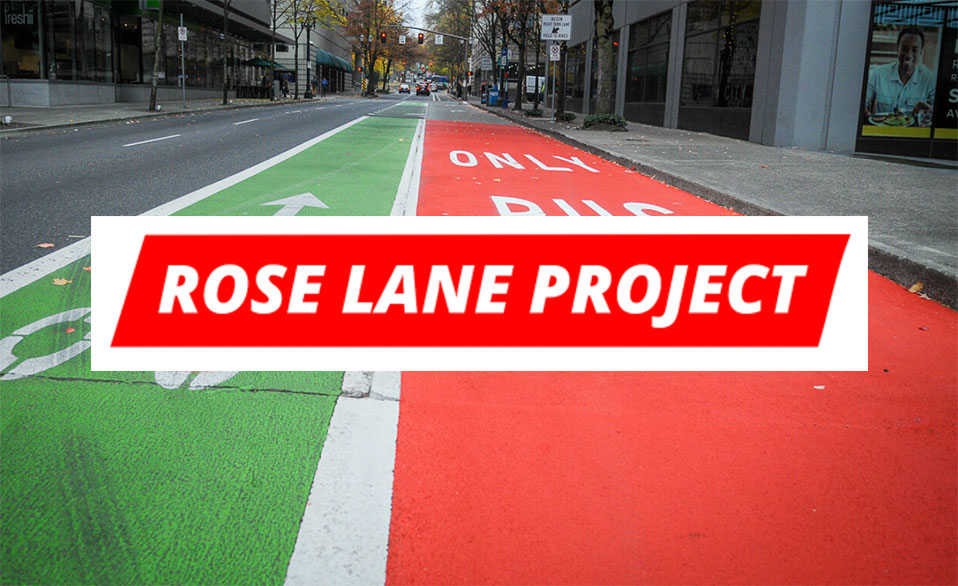
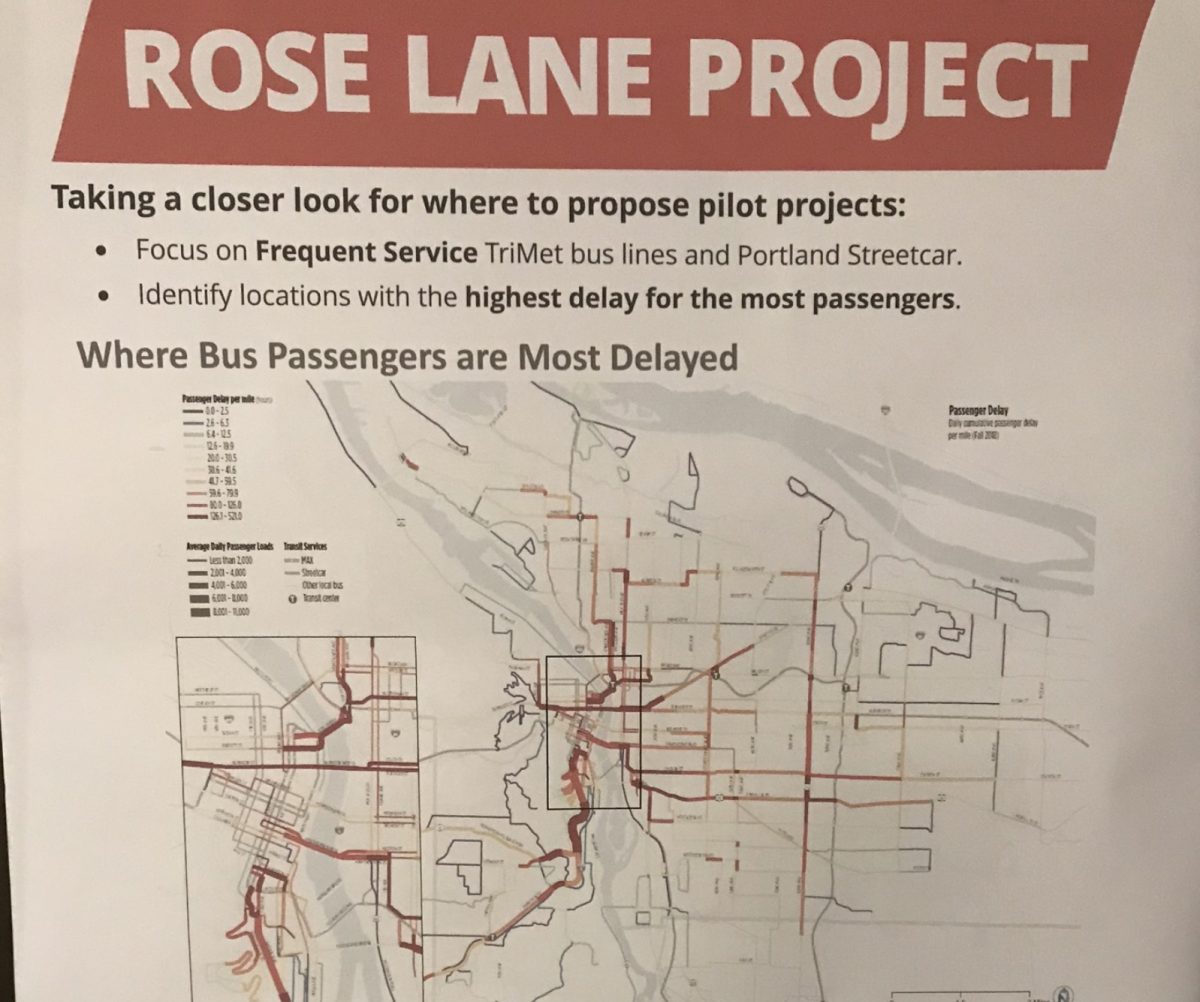
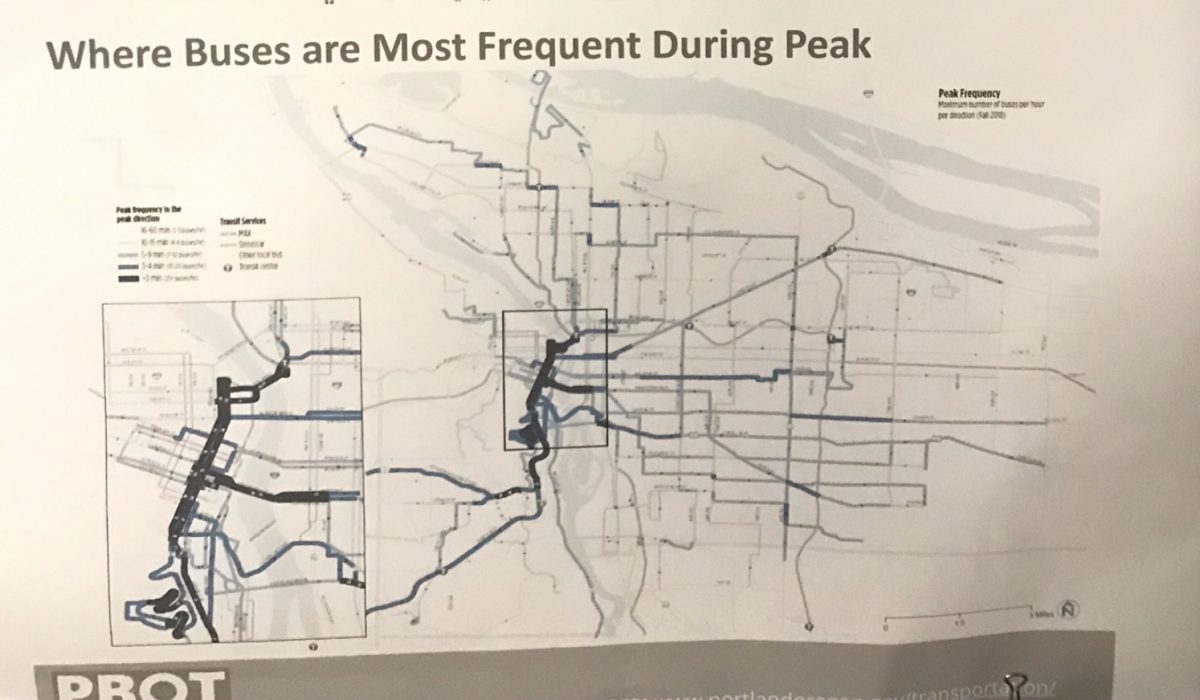

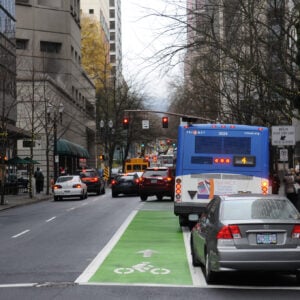

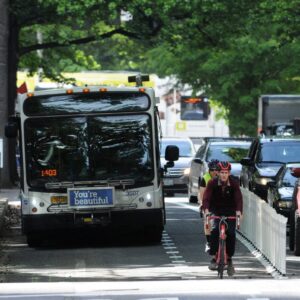
Thanks for reading.
BikePortland has served this community with independent community journalism since 2005. We rely on subscriptions from readers like you to survive. Your financial support is vital in keeping this valuable resource alive and well.
Please subscribe today to strengthen and expand our work.
To put a finer point on it: “Our primary goal is to allow people of color to reduce their commute time,” Duhamel said.
The best way to do that is through affordable housing so that we have mixed communities. If we focus on just the transportation options, it will not take into account communities that change over time.
I get it, Portland has a terrible history in regards to race, but I feel like the focus on transportation is misguided. If we really cared about addressing the past we’d be talking about affordable housing and reparations. Instead we shut down improvements that would positively affect the health and safety of all residents in the name of equality, all while ignoring the giant overpriced condos going up on Williams. Punching down is easier I guess.
Hi Jeff, I think what you might not fully understand is that this isn’t about history… This is about the present day. Right now people with less money and darker skin suffer from a system that is biased against their color and economic standing. And not sure who the “we” is in your comment, but what you think might be helpful to certain groups of people in our community might not be what they find to be helpful… and that is what I think Eudaly is trying to do here. Go directly to people impacted and say “What sucks for you and how do you want it to be fixed?” I think that’s pretty powerful and I’m eager to see what results.
I think I was responding more generally to proposed transportation improvements that ultimately do not happen because of concerns around race and history, and less to this particular instance, which I do very much agree is worthwhile. I appreciate the response and thoughts, sorry for the misguided comment.
Stakeholders who are nearby residents objecting to alternative transportation (SWANROATs) are commonplace everywhere regardless of local history/race/ethnicity.
Punching down??
It’s interesting that in our society we’re pretty clear about things like blackface but can’t reach consensus about the remedy for four centuries of outrageous abuse with measurable economic impact. Your point about reparations is well taken.
You say this like it’s not one of the major focuses of Comm Eudaly and her staff’s work. In fact, Eudaly’s focus on housing affordability and tenant rights has already led to the uniquely effective “Renter Relocation Policy”, the FAIR ordinance (addresses screening equity), and security deposit reform. Additional policies that directly address the root cause of the affordability crisis — runaway rent speculation — are being actively worked on.
You can certainly tell by who is living and driving here, and who is sleeping in tents, how
effective Chloe is, can’t you?
Eudaly is now responsible for the homeless?!
Weird.
What is “weird” is you would chime in to put words in my mouth….
Point out when I said she was responsible for the homeless problem?
She is not responsible, she just simply does nothing about it. We have a Mayor and a city council who are letting this city get trashed with absolutely no plan to do anything about it except play whack a mole.
If you think the homeless issue is being addressed at all by Chloe, please let us know what her plan is, I can’t seem to find out…..
“You can tell by who is […] sleeping in tents how effective Chloe is…”
“She is not responsible, she just simply does nothing about it.”
Nice try weasling out of that one.
Chloe was assigned the transportation bureau wasn’t she? Why does what she does or doesn’t do put people in tents?!
Neither the mayor nor city council have any interest in “solving” the homeless problem. There is too much money flowing into the homeless-industrial complex. People should start asking how much public money is being siphoned off by so-called homeless advocates while the problem only gets worse.
We need the same approach but for biking. I hope any conversation with frontline communities and bikes includes and highlights people experiencing homelessness.
This appears to be a normal run of the mill alternative transportation proposal all gussied up in the language of social justice. While I applaud all efforts at helping make the city less automobile-centric and safer for pedestrians and cyclists I am more than a little concerned that the conflation of alt-transportation projects with the social justice mindset (I.e.; disparity is always emblematic of discrimination) will serve to further polarize the community and make these projects even more difficult to accomplish in the long run.
Rhetoric aside, how does this proposal differ from one where race were not a consideration, but focused solely on making improvements to the system where they would have the greatest impact?
I attended a bike/walk summit here in NC, in Winston-Salem, over the past three days. We had several presentations on public transit and how people of color use walking, bicycling, and transit services and facilities, but more importantly, general attitudes about walking, bicycling, and transit, which for me as a white bike-dependent MAMIL were quite eye-opening.
The main take away was that well over 50% of all Americans got no significant exercise during the past month. Over 50%. This percentage was somewhat higher among African-Americans and Latinx, but it was still very high even among whites. There was some geographic variation – the South (were I live) was a bit more sedentary, the West a bit less, but the rates were didn’t vary as much as you might think. And the older and poorer you are, the less likely you got any exercise and the more likely you live in a geographic area with less opportunities to exercise and poorer housing choices. The harder you work, the longer hours, low pay, the less time you have available to use other modes or to exercise, the more tempting to eat fast food and processed food.
The second big take away was racial versus cultural attitudes towards alternative modes. For most Americans, but even more so for immigrants and people of color, the use of public transport, walking, and bicycling was closely associated with a lack of independence, lack of opportunity and poverty. For many poorer people, buying a car was everyone’s major goal in life, as it gives people greater access to jobs (and it does, alas), greater safety (sort of does), and raises their social status among their family/peers. For many people of color, just using alternative active transportation modes exposes such users to greater negative interaction with the police, their paranoid white neighbors, and “criminals”. Bike paths are apparently very strongly associated with crime, rape, and murder for African Americans here in NC, even though there’s absolutely no statistical evidence to back up such a hypothesis.
The third and final take away I’ll share (there were many others) is that disparities are not just racial, but more often cultural, geographic, institutional, age, etc. In a lot of poorer Eastern communities, one sees big commercial billboards and TV ads that often say something like “Outdoor Activity is Overrated” (this from ESPN and Direct TV). Cultural attitudes of “when are you going to stop running around and settle down and have kids?”. Basically cultural attitudes that discourage exercise and an active lifestyle. We active transportation advocates are having to fight an uphill battle against such attitudes, culture, and commercial interests, some of which might be racial biases, but many are not.
Those of us who bike, walk, or use transit at least once per week are a tiny minority. The vast majority didn’t use any of those modes during the past month for any trip, and at most will use them only at open-streets events or to go to the stadium. Our target, in reality, is what you might call the “interested but concerned”, but not just cyclists, but also walkers, transit users, and others, people who are willing to exercise (a bit, but not too much) but who live in an area without opportunities to do so, and who tend to be white, middle-class, and actually have a little free time available. Not a lot of people, really.
“I am more than a little concerned that the conflation of alt-transportation projects with the social justice mindset (I.e.; disparity is always emblematic of discrimination) will serve to further polarize the community and make these projects even more difficult to accomplish in the long run.”
If a historically marginalized community is currently being impacted by a disparity, I’d be hard-pressed to say that that is a mere coincidence. Given that such communities are suffering from multiple other disparities in the present day, the burden of proof would be on those who don’t believe a given disparity results from discrimination. “You were historically discriminated against but that’s in the past, and the disproportionate impact of this transportation project on your community isn’t necessarily the result of discrimination” is not a particularly compelling argument. Furthermore, this “social justice mindset” as you call it is merely the statement of truths and the desire to resolve issues of inequity. Even in a hypothetical world where a given disparity isn’t the result of discrimination, wouldn’t you want to resolve that anyway? It seems paternalistic and even sinister to say that the government shouldn’t discuss certain issues just because it will polarize the community.
The condescending tone of how projects like these are presented is palpable. More progressive white people treating people of color as if they have no ability or intelligence to help themselves. It’s sickening.
I mean, I agree, but regardless of race or income level, people *do* need the city to help paint bus lanes.
Too much time living in the world of Power Point slides and you get stuff like this. Sad.
A day late and a dollar short…
Portland is pretty much gridlock at times, bike commuting way down because a lot of people who ride bikes are not living here now due to the cost of housing which the city has not addressed except to allow a gazillion expensive apartments to be built.
Thanks for nothing, Chloe.
Expensive apartments are driving down the cost of housing.
Care to provide some stats for that?
Expensive housing has driven the cost down so quickly in SF and Seattle hasn’t it?
Bound to work here…..
San Francisco and Seattle aren’t building expensive housing fast enough to drive down prices. My claim is unfalsifiable. (Also illogical and probably wrong.)
Wow, comments on this are really discouraging. I think this is awesome. Transit is the most effective way for us to dramatically shift from SOV; and improving transit efficiency and approaching it with a racial equity lens is fantastic. The city doesn’t have a lot of tools to impact transit, but this is a key one – and they are making it a priority. KUDOS to Eudaly and her team!
I hated her when she was running against Novick (wanted parking to be required for everyone because she had to be able to drive her disabled son), but she has learned a lot. Willing to stir up trouble, and I’m appreciating that.
Chloe is legit.
And I like the focus on branding and visual identity. Imagine roses stamped on bright red lanes throughout the city!
I am concerned that the City may focus on these transit enhancements in place of Central City in Motion and similar bike-oriented projects. Transit and bicycling/scooters/rollers/etc. are complementary. Both should be done.
I like this project but it kind of feels like the workflow at the city has become:
1. Unilaterally do whatever we want.
2. Sprinkle some “social justice” on it at the end so that anybody who opposes us can be
accused or racism.
3. Ship it!
A 5 minute difference in commute times!? How many minutes do people of color lose each year being to forced to listen to white progressives groveling about “oppression”?
Zero minutes of required listening to anything.
Five minutes per day on average, over all transit riders, for 250 days each year? That’s something. The five minutes represent many fewer bumping stops and starts which are one of the major deterrents to transit riding. There’s also a public good: the buses will last longer.
Before we all get carried away on the social-justice angle, let’s remember two things:
1) Dedicated bus lanes are the right thing to do – for everybody. Why should people who do the right thing by all of us have to wait in traffic while people in SOVs hog the road? (example: SW Capitol Hwy going up the hill to Hillsdale every night, as buses wait in traffic to get to the stop at Sunset while SOVs clog the lanes). We need to flip the script: choose to drive alone and you will suffer the inconvenience of having to wait for people who are doing the best thing for all of us. (And before you say “Some people *NEED* to drive alone,” I will say “Try a little harder to carpool.”)
2) We *HAVE* to do it.
I agree. The case for bus lanes stands pretty well on its own.
https://www.youtube.com/watch?v=sHeUk4Ns5ss
It seems to me that dedicated bus lanes are only the opening gambit in creating a BRT system. Why not just say that, it’s super cool!
“ It’s not clear yet where the funding will come from.“
Great. I won’t hold my breath hoping this becomes the first time in contemporary Portland history the city doesn’t over promise on plans and underfund on implementation.
In general, where there’s a political will, funding will be found. Most projects that fail, especially in East Portland, are those that are well-funded but completely lack any political will.
This is awesome. It’s going to take a lot of love to heal wounds and work together on common goals. More in-depth articles including history and viewpoints please.
Sigh… Chloe, can we talk about something in terms not likely to fan the culture war? I think this shoehorning everything into the framework of racial equity is absurd and ineffective. Why not throw in #MeToo and gender fluidity to cover all your bases. Making it *harder* for people to drive SOVs is hard enough without the added weight of this baggage.
The burgeoning “field” of “transportation equity” or whatever they call it is fashion in search of a demographic. Its like a bad musical genre mashup that nobody actually wants, but seems inevitable. Love metal AND love rap? You’ll REALLY love rap-metal! Into racial equity and sometimes you drive past poor people waiting at the bus stop and feel sorry for them? You’ll LOVE transportation equity!
This is not a real constituency, its a glut college kids who’ve been exhorted to “activism” with not enough issues to go around.
This whole comment is so tired. Please put it to bed.
I don’t know how I get out of bed in the morning without her help.
On the one hand, as JM says, we are going to historically disadvantaged populations and asking “What sucks for you and how do you want it to be fixed?”
And the equally smart DH points out that:
“For most Americans, but even more so for immigrants and people of color, the use of public transport, walking, and bicycling was closely associated with a lack of independence, lack of opportunity and poverty. For many poorer people, buying a car was everyone’s major goal in life”
But, if the decision -makers attempt to change those associations, they are accused of “not listening” and other unsavory attitudes.
Am I being naive in feeling that we can’t fix both things at once? Certainly not in time to make a difference.
The answer may well be “walking and taking the bus sucks for me, and you can fix it by helping me drive my car like every other person who’s made it”.
followed by: “Now that I’ve finally achieved this mark of success, you’re trying to devalue it?”
IMO, our relationship with transportation modes is far more complex than simply getting from point A to point B in the safest, most comfortable and efficient manner possible.
For many of us, maybe all of us, how we choose or prefer to get around is part of our identity. I primarily bicycle, but I also walk, use public transit, am a passenger in a carpool on occasion, I use AMTRAK whenever possible, and I sometimes even fly – but I never learned to drive, so part of my identity involves my never driving. I am known locally as “that Portland bike nut”, but I recognize that most people where I live drive everywhere as our community is well-known nationally as the most car-friendly city in the USA (and least congested.)
We need to recognize that many people, including many homeless, many people of color, and for many others who are vulnerable in our community, the personal automobile is an object of value: Not only can you use it to go places, but among other things it also provides all-weather shelter and acts as a status symbol for its user(s). This is not all that different for bicycles for many of its users – we too often boast of our Surly and other status-brand ownership, our being brave to ride in miserable weather, the awful routes and traffic we have to endure.
When you are aiming to fix two things at once, always a worthy task, it helps to separate what you are trying to fix from all the other baggage or components of what doesn’t need fixing (or is far less important.) Car ownership in of itself is not a problem, it’s the movement of cars and the pollution they cause that is the issue that we need to deal with. So let people continue to strive to achieve their Lexus dreams, but it’s OK to restrict their movements, as long as the restrictions are fair and equitable.
I’d start by banning car parking on all collector and arterial streets, as Gresham and Multnomah County has already done, to allow faster bus movement, but to compensate, allow even the homeless and people who are driving while black unrestricted parking access on neighborhood streets, even so far as to set up camps.
Does anyone else find it ironic that she flew to Europe to attend a conference on congestion pricing and then comes back to lecture us on climate change?
Maybe ironic, but certainly not something I look down upon or wish she wouldn’t do. In my opinion (which from what I can see is shared by most climate academics and activists), the top, I dunno, 50 things that humanity is not doing to address carbon emissions, but should and could realistically do, are all government policy. Cutting carbon emissions by stopping government officials from flying to conferences on carbon-relevant topics would be carbon-ounce-wise but carbon-pound-foolish in the extreme.
Well, one hand I agree. There are quite a few places just in my neighborhood in south east where you could learn plenty about congestion. Certainly enough to figure out the whole SOV clogging the road thing, and need for more efficient mass transit. Seriously, just watching a single bus stuck behind a line of cars on Holgate proves this point in like 5′.
But, and more so, I disagree. Invalidating someones point (in this case, quite legitimate point) due to them not being pure enough is just ludicrous.
Maybe if she had sailed there she would be taken seriously by you…